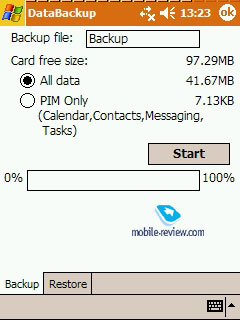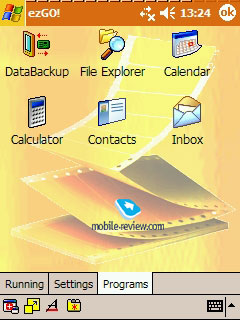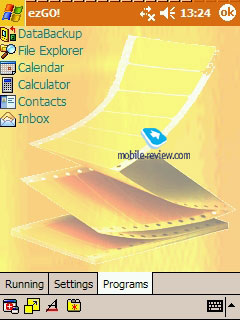|
|
Review
Palmax GDA
Package:
- PDA
- Charger
- USB cable for synchronization
- Car charger
- Car holder
- Stereo hands-free
- CD with the software
- Manual
A Taiwanese company Compal isn't that popular on the international market under its own brand. But we know well products of Toshiba (notebooks, PDA in the past) and Motorola (some budget phones), which are manufactured at Compal's plants against ODM-contracts. After several years' break Compal decided to enter PDA market with its brand Palmax. The reason is simple - after Toshiba had left PDA market and Motorola had canceled the MPx communicator, Compal lost its ODM-partners on PDA and communicators, and now it has to promote final products with own forces. Under the Palmax brand there were released Palmax Z710 (a successful budget PDA, one of the best in its class) and Palmax Z720 (a copy of the Z710, but with built-in satellite receiver and an external antenna).
The impact of falling sales makes PDA-manufacturers find the functions that would attract customers. Currently there are two directions that drag the vanishing PDA market to the top: satellite navigation (GPS) and built-in HDD. Almost all companies add or have already added GPS-products to their lines, some companies stack on GPS only (for example, MiTAC, Asus).
Palmax GDA is a navigation PDA for car use. The abbreviation GDA means GPS Digital Assistant. This is one of the first handheld computers based on GPS SiRF Star III chip. We can remember the upgrade of MiTAC Mio168, besides Palmax Z720 was also upgraded to the third version of this chip. MiTAC Mio169 appeared in shops earlier than the Compal's model. Before we pass to the next part of the review, we tell you about GPS and SiRF Star III, so you see the key difference between the 3rd and the 2nd versions of the chip.


In mid 60-s of XX century military organizations realized that navigation systems of that period didn't ensure required accuracy. Naturally they looked to near space. The first satellite navigation system was called Transit that consisted of 6 satellites, a creation of the US Department of Defense. Determination of position was based on Doppler effect. The satellites revolved on the known trajectory and broadcasted at known frequency. The receiver got the signal of some other frequency (that's the essence of the effect). So the position was calculated on frequency bias of several satellites. The satellites detected the position worldwide every 1.5 hours with the accuracy up to 200 meters. The satellite system Transit existed till 1996.
The birth date of the Navstar Global Positioning System (known as GPS) is 1973, when the US Department of Defense initiated navigation system unification process (different departments worked on different systems that weren't compatible).
The new system has fundamental differences from Transit. In case of GPS each satellite carries several atomic clocks and communicates its position and exact time with the signal. GPS compares this data with inner time and locates the position in 3 coordinates. At the same time there is no need in high-accuracy clock in the receiver, the clock should be accurate within short period of time.
In general, the system is based on 3 elements. Firstly, there should be at least 24 satellites (30 functional satellites for May 2005), each of them turns round the earth twice over 24 hours distanced 20 thousand km above sea level. The satellites of last generation (Block IIr series or higher, currently 12 units launched) are networked and can update motion parameters without the assistance from the earth. Secondly, there should be terrestrial control centers to track orbits, synchronize time among satellites and coordinate them. It's possible to change satellite broadcasted data from terrestrial stations. Thirdly, there should be the very GPS-receivers.
Despite of the fact that the annual maintenance of the system (including satellite park update) costs some half a billion of US dollars, common users do not have to pay for the satellite signal, they just need a GPS-receiver and open space. However SiRF STAR III chip doesn't require open space.
Before 2000 open and military GPS signals were separated, it was called Selective
Availability. The signal for common users (not military) had an artificial inaccuracy, so the positioning error was up to 100 meters. On May 1, 2000 the US President Bill Clinton announced the cancellation of Selective Availability. Now the positioning error doesn't exceed 20 meters (and even less if you apply some tricks).

Any GPS-receiver is based on a GPS chip, which is like CPU in Pocket PC or GSM (UMTS) chip in a cell phone. There is SiRF company on the GPS chip market, its solutions are used by many manufacturers, including Holux. An important milestone was the emergence of 3G chip SiRFstarIII. It's a new step in personal satellite navigation development. See the table below to compare SiRFstarIII with the 2G chip.

The key advantage of this chip is higher sensitivity, ability to work indoors and to use integrated antenna. The model picked up steadily 5-6 satellites while driving among multistory buildings in the city. When the signal reception quality was poor, there was no problems either - at least 4 satellites picked up. If you lay the device on the window sill (12th store of an 18-storey building), the norm will be 3-4 satellites. Interesting fact is that during the air route I chanced to locate position several times during a long flight, I ran the experiment for fun, as few people believed it was possible.
The shell is made of dark grey plastic, so the device doesn't stick out above the dashboard that much, the sides are of uneven black plastic to minimize sliding in hands. As we've already said the device is meant for car use first of all (60% according to the company), and the rest (40% respectively) for ordinary PDA use. Control elements have respective location - they are landscape oriented.

Palmax GDA is meant for playing games, at least the developers planed so. Above the screen (to be more exact - to the left of the screen) are 2 sound volume buttons, at the landscape screen orientation they can be used as A/B buttons for gaming. But if we consider the GDA as a gaming device, we come across a weak point - the location of the joystick and four neighboring buttons - they should have been replaced. The gamers used to have a navigation button under the left thumb, and buttons for the right hand, in case of the GDA everything is vice versa. Other control elements are a separate screen orientation button (!), a hold button, SD/MMC slot with SDIO support, miniUSB connector for charging and PC connection.


Its Li-Ion battery is capacious of 1320 mAh, in PDA mode the GDA is good for 8 hours, if the GPS is on, the battery life lasts for 5 hours. Surprisingly, the real tests revealed that claimed figures are at least not overestimated. Under the maximum load (312 MHz, video playback from the memory card, highest backlight level) Palmax GDA worked for 3 hours 15 minutes, in the book mode (the lowest backlight level, 104 MHz, auto scrolling) - 13 hours, that's a good performance resulted from the fact that with high capacity battery you can manually set low clock rate.

There is no problem to speed up Palmax GDA's processor Intel XScale PXA270 with XCPUScalar utility to 520 MHz. Well, don't get confused with the highest clock rate claimed (312 MHz), if you need more speed, so speed the processor up. 512 MHz is enough to cope with any tasks, for example, video playback without re-conversion, heavy games. There is 52.8 MB of available RAM onboard.
The screen doesn't stand out among similar models with QVGA resolution (320x240 pixels). 3.5" diagonal, TFT-screen, 65K colors, good performance under the sun - in all, this is a typical Pocket PC QVGA screen without peculiarities.
I'd note that there are no wireless adapters, such as Wi-Fi and Bluetooth, the manufacturer decided them unnecessary here. It's a definite drawback, if you plan to use Palmax GDA not only as the navigator in car, but also as a full value PDA.
Software
The handheld is powered by Windows Mobile 2003 for Pocket PC Second Edition. You can read about its standard applications in the article published on our site. There are two extra programs for this PDA - DataBackup to make reserve copies and ezGO - a similarity of application manager, its opportunities are quite scares. This is typical set of programs for Palmax PDAs, I'd only note the new thing - profile control: you can adjust speaker and headphones volume and backlight level.





Conclusion
Palmax GDA is one of the first PDA based on new SiRF Star III chipset and the first GPS-device with internal antenna. Taking into account price/quality ratio (the retail price is $350-400) we have a good solution to be used mainly in cars. If we consider it as the full value PDA, we'll obviously lack Bluetooth, Wi-Fi and a VGA screen. In this case you'd better consider the pair PDA + external GPS module.
It's interesting to have a look at the future products of the company, the development of the iNavi line. In the beginning of this article we mentioned GPS and HDD as main development directions, the new line has all of it. I'd say this info is preliminary, so it can be changed by the announcement and some products might be cancelled.
- 4Q 2005 GDA II - the switch to 3.5" VGA screen, other specs are the same
- 4Q 2005 IP GDA - Wi-Fi and Bluetooth in addition to VGA screen
- 1Q 2006 Venture - the most interesting product in the line. 4" VGA screen, built-in1.8" 20 GB (!) HDD, FM-receiver.
- 1Q 2006 City Walker - a tiny PDA version for walking navigation, 2.8" screen and small dimensions. This is the direct rival of HTC Galaxy.
- 2Q 2006 IP Venture - a version of Venture with Bluetooth and Wi-Fi.
- 2Q 2006 IP Walker - a version of City Walker with wireless adapters.
- 3Q 2006 City Walker HD - 2.8" screen, tiny dimensions, 0.85" 3 GB HDD.
Description:
- Class: GPS Pocket PC
- Position in the line: above Palmax Z720
- Rivals: Palmax Z720, MiTAC Mio169, Asus MyPAL A632
- Operating system: Windows Mobile 2003 Second Edition
- Processor: Intel XScale PXA270 312 MHz
- RAM: 64 MB (52.80 MB available to the user), 128 MB optionally
- ROM: 64 MB (15.94 Мб available to the user)
- GPS: SiRF STAR III, built-in antenna, external antenna can be plugged
- Connectivity: SD/MMC slot (SDIO support), IrDA, miniUSB for charging and synchronization
- Screen: 3.5" (active zone: 53x71 mm), 240x320 pixels, 65K colors
- Landscape orientation of control elements
- Battery: removable Li-Ion 1320 mAh. Battery life claimed:
- 8 hours in PDA mode (GPS off)
- 5 hours in navigation mode with GPS on
- Dimensions: 121x71.5x17~22 mm
- Weight: ~140 g
Anton Kotov
(anton.kotov@mobile-review.com)
Translated by Anja Rytchkova (anja.rytchkova@mobile-review.com)
Published - 28 August 2005
Have something to add?! Write us... eldar@mobile-review.com
|
News:
[ 31-07 16:21 ]Sir Jony Ive: Apple Isn't In It For The Money
[ 31-07 13:34 ]Video: Nokia Designer Interviews
[ 31-07 13:10 ]RIM To Layoff 3,000 More Employees
[ 30-07 20:59 ]Video: iPhone 5 Housing Shown Off
[ 30-07 19:12 ]Android Fortunes Decline In U.S.
[ 25-07 16:18 ]Why Apple Is Suing Samsung?
[ 25-07 15:53 ]A Few Choice Quotes About Apple ... By Samsung
[ 23-07 20:25 ]Russian iOS Hacker Calls It A Day
[ 23-07 17:40 ]Video: It's Still Not Out, But Galaxy Note 10.1 Gets An Ad
[ 19-07 19:10 ]Another Loss For Nokia: $1 Billion Down In Q2
[ 19-07 17:22 ]British Judge Orders Apple To Run Ads Saying Samsung Did Not Copy Them
[ 19-07 16:57 ]iPhone 5 To Feature Nano-SIM Cards
[ 18-07 14:20 ]What The iPad Could Have Looked Like ...
[ 18-07 13:25 ]App Store Hack Is Still Going Strong Despite Apple's Best Efforts
[ 13-07 12:34 ]Infographic: The (Hypothetical) Sale Of RIM
[ 13-07 11:10 ]Video: iPhone Hacker Makes In-App Purchases Free
[ 12-07 19:50 ]iPhone 5 Images Leak Again
[ 12-07 17:51 ]Android Takes 50%+ Of U.S. And Europe
[ 11-07 16:02 ]Apple Involved In 60% Of Patent Suits
[ 11-07 13:14 ]Video: Kindle Fire Gets A Jelly Bean
Subscribe
|












